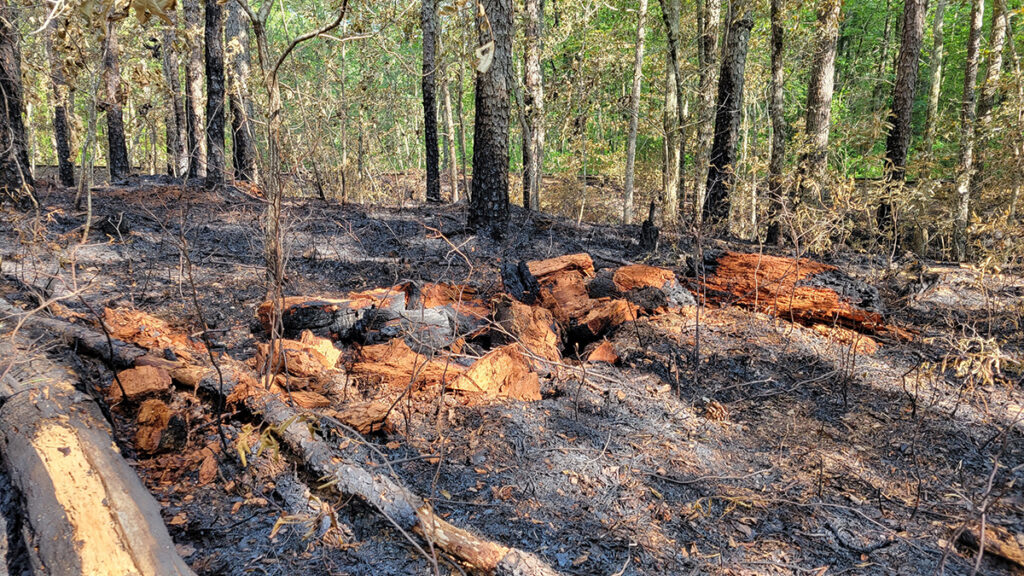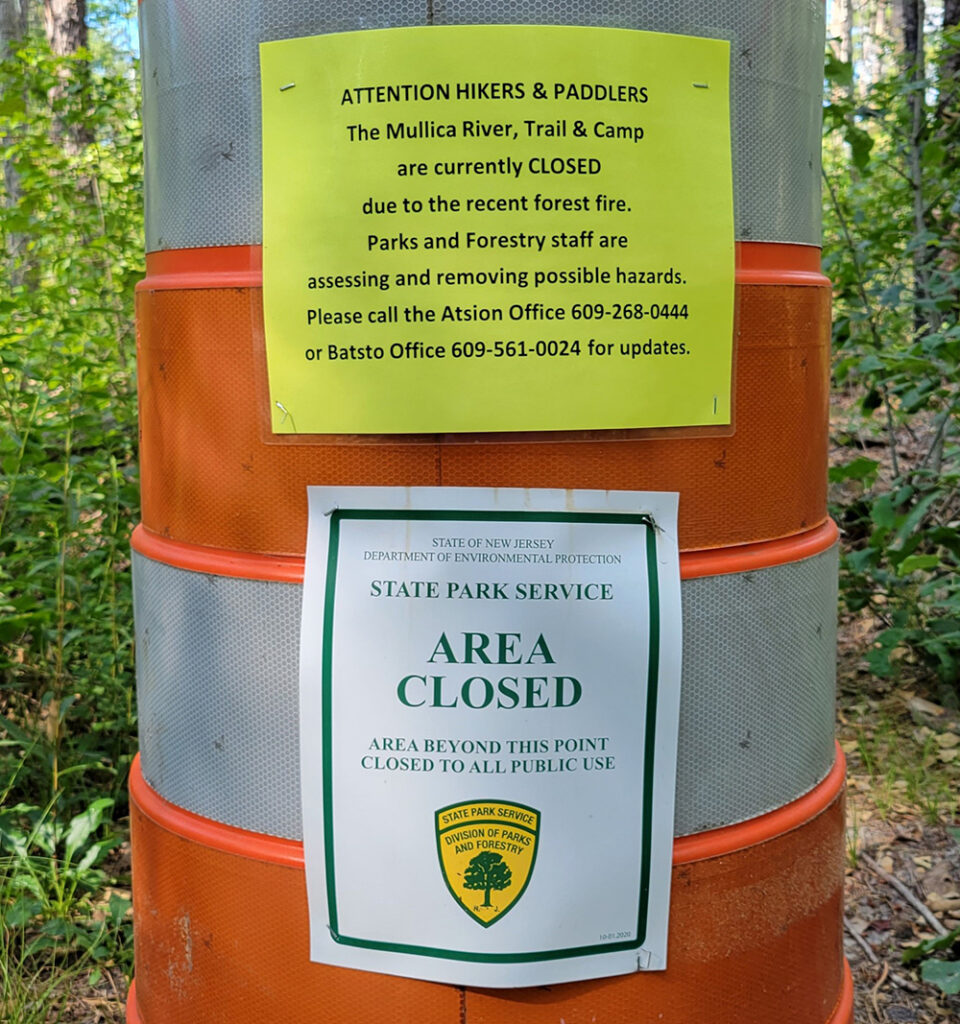Main Content
Sal Mangiafico, Rutgers Cooperative Extension
Our forests are invaluable
New Jersey’s forests are invaluable for the services they provide. These include being a home to valued plants and wildlife, providing recreation opportunities, and supporting ecosystem services like recharging aquifers, improving water quality, and serving as a carbon sink.
Recently, a large wildfire in Wharton State Forest has reminded us of how much we value our forests.
Fire
The recent Mullica River Fire affected nearly 14,000 acres along the Mullica River in Wharton State Forest in Burlington and Atlantic Counties (NJ.com, 2022a). The fire spread along the Mullica River between Atsion and Batsto, and closed roads, hiking trials, recreation areas, campgrounds, and river access. One report was that 50 residents had to be evacuated (NJ.com 2022b). The wildfire may have been started by an illegal campfire (NYT 2022).
Why fire is important to pinelands forests
Wildfires are inherently dangerous because they are uncontrolled. They can threaten homes, wildlife, and mature trees.
However, New Jersey’s pineland forests are adapted to fire, especially surface fires, that move along the ground burning leaf litter and downed wood without reaching the crowns of the trees. Here, fires are natural and relatively frequent. Fire helps break down leaf litter and dead wood, which may not readily compose in the relatively acidic and dry soils.
Some trees are protected from fire by having a thick bark that protects the living tissue inside the trunk. Trees and plants may regrow after damage from fire. Some herbaceous plants have rhizomes, which are underground stems, that can resprout after a fire. Some pitch pines, for example, have serotinous cones, that don’t open until they are affected by the heat of a fire.
The Academy of Natural Sciences (ANS) at Drexel University notes:
“Native bees in the Pine Barrens are usually winners. As strong flying insects, bees can get away from the heat and smoke. And since many nest underground or in dead wood, their young are also better protected. Both traits usually allow for a resurgence after the fire has passed.”
(ANS 2021)
Foresters sometimes conduct prescribed burns to remove accumulated downed wood, which prevents future wildfires from being too intense, and to revitalize the pinelands forest.
Other Forest Threats: insects, diseases, and deer
Our forests face a variety of challenges. Our March news blast discussed the potential for an overpopulation of deer to negatively impact forests by overbrowsing the understory, removing tree seedlings, and eating certain wildflowers (Mangiafico, 2022).
In addition, our forests can be negatively impacted by the presence of invasive plant species, problematic insects, and devastating plant diseases. The New Jersey Forest Service (NJFS) notes:
“While most insects and diseases are part of the natural ecosystem, the NJFS is mainly concerned with forest health threats that are invasive, spread quickly, or can have the ability to affect otherwise healthy trees. Often the pests and diseases of concern are non-native and introduced to our forests accidentally.”
(NJDEP–NJFS 2022b.)
Some current threats include:
• Insect pests like the spotted lanternfly and emerald ash borer throughout most of the state, and the southern pine beetle in the southern part of the state.
• Plant diseases like beech leaf disease in the northern part of the state and Dutch elm disease throughout the state.
See NJDEP–NJFS (2022b) for more potential threats to our forests and information on specific insects and plant diseases.
What can you do?
Fires
• Never leave campfires unattended.
• Never have campfires at prohibited times or areas.
• Put out fires completely.
• When there is a high danger of wildfire, be careful with smoking materials and hot vehicle exhausts.
Invasive species, insects, and diseases
• Don’t move firewood.
• Don’t pack a pest. Clean recreational gear and check outdoor items you transport for unwanted visitors like spotted lanternfly eggs.
• Don’t plant invasive or aggressive non-native plants on your property.
Forest management at home
• If you have a forested area on your property, consider consulting a professional about good woodland management practices.
• Investigate your town’s Natural Resources Inventory to determine forest tracks in need of protection.
• Consider serving on your town’s environmental commission or green team.
References
[ANS] Academy of Natural Sciences at Drexel University. 2021 Jun 28. Fire in the Pine Barrens. www.anspblog.org/fire-in-the-pine-barrens/
Mangiafico, S. 2022 Mar. Will Saint Patrick Lead the Deer Out of New Jersey? salem.njaes.rutgers.edu/2022/03/01/will-saint-patrick-lead-the-deer-out-of-new-jersey/
[NJCF] New Jersey Conservation Foundation. 2020. What’s valuable about New Jersey’s forests? Earth Day Every Day.
www.njconservation.org/whats-valuable-about-new-jerseys-forests/
[NJDEP–NJFS] New Jersey Department of Environmental Protection – New Jersey Forest Service. 2022. Forest Health Program in New Jersey. www.nj.gov/dep/parksandforests/forest/foresthealth/index.html
NJ.com. 2022a Jun 24. Huge Pinelands forest fire ranks among N.J.’s 20 biggest wildfires on record.
www.nj.com/news/2022/06/huge-forest-fire-in-south-jersey-ranks-among-njs-20-biggest-wildfires-on-record.html
NJ.com. 2022b Jun 23. Massive N.J. forest fire grows to 12,000 acres, but fire crews making substantial progress. www.nj.com/news/2022/06/massive-nj-forest-fire-grows-to-12000-acres-but-fire-crews-making-substantial-progress.html
[NYT] New York Times. 2022 Jun 21. Wildfire in New Jersey Could Become the State’s Largest in Years. www.nytimes.com/2022/06/21/us/new-jersey-wildfire.html

